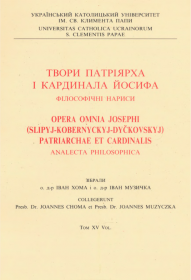The works of Patriarch and Cardinal Joseph in 15 volumes. Vol. XV. An outline of the history of medieval (scholastic) philosophy: Rome, 1991, Universitas Catholica Ucrainorum S. Clementis Papae, 181 p.
Keywords:
history of philosophy, scholasticismSynopsis
In this work, written in the 1940s and reproduced from memory in 1974, Josyf Slipyj provides a general overview of medieval philosophy. The author does not delve into details, but seeks to outline the main contexts—historical, cultural-social, and geographical. The book is thesis-based and offers the reader a comprehensive view of the development of philosophical thought within the Christian, Arab, Jewish, and Byzantine-Ukrainian traditions.
Oleksandr Lukovyna
Сontents
From the publisher
Foreword
Part One. Patristic philosophy
I. The end of ancient philosophy and the origin of Christianity
II. The beginnings of patristic philosophy
III. The main representatives of Eastern patristic philosophy
IV. John of Damascus – the greatest systematist of Eastern patristic philosophy and theology
V. Western – Latin philosophers from the pre-Scholastic era and St Augustine
VI. Boethius and the state of the science of philosophy in schools in the West in the 8th and 9th centuries
Part Two. The beginning of scholasticism
I. The concept of scholastic philosophy and theology and a view of its historical course
II. A corrected view of scholasticism
III. Sources and literature
IV. The first philosophical works of the Scholastics
Part Three. Arabic philosophy
I. The emergence of Arabic philosophy, in particular in the East
II. Development of Arabic philosophy in the West
III. Mutakallimūns' philosophical view of the world
IV. Arab mystics
Part Four. Jewish philosophy
I. The Kabbalistic trend
II. Avencebrol
III. Maimonides
Part Five. The golden age of scholasticism
I. Harbingers of the Golden Age – Peter Lombard and the Victorian School
II. St Albert the Great (1193-1280) – the first representative of the Golden Age
III. St Thomas Aquinas and his youthful age
IV. The University of Paris
V. Contemporary trends in philosophy and theology
VI. Thomas in Italy
VII. Second life at the University of Paris (1269-1272)
VIII. Thomas's last days in Italy
IX. Summa Theologiae and its influence on theology
X. A look at Thomas's work
XI. Bonaventure (1221-1274)
XII. Henry of Ghent (1217-1293)
XIII. John Duns Scotus (1266-1308)
XIV. The natural sciences
Part Six. The Stagnation of Scholasticism in the XIV and XV c.
I. Scholastic philosophers and theologians after the Golden Age
II. Nominalism of William of Ockham and his followers
III. German mysticism and Meister Eckhart
Part Seven. Scholasticism in Byzantium and Ukraine
I. The first information about the science of philosophy in Ukraine
II. Negative views on Ukrainian scholasticism
III. Rehabilitation of Scholasticism in Byzantium and Ukraine
Part Eight. The Transitional Era from Scholasticism to Modern Philosophy
I. The state of scholastic philosophy in the XV and XVI centuries
II. Restoration of philosophy by humanists
III. Peculiar views of some authors in their philosophical works
IV. Creative researchers of nature
Part Nine. The revival of scholasticism
I. The first Dominican renewers of scholasticism in Spain and Portugal
II. The scholastic school of Jesuits and Scotists
Part Ten. A general overview
I. Scholasticism in the West
II. Byzantine and Ukrainian scholasticism
Appendices
1. Review of the book by Étienne Gilson
2. Extracts from Prof. M. Marchenko's work «Ukrainian Historiography»
Downloads




